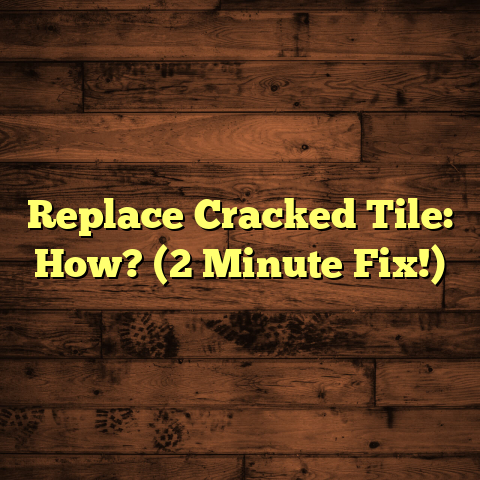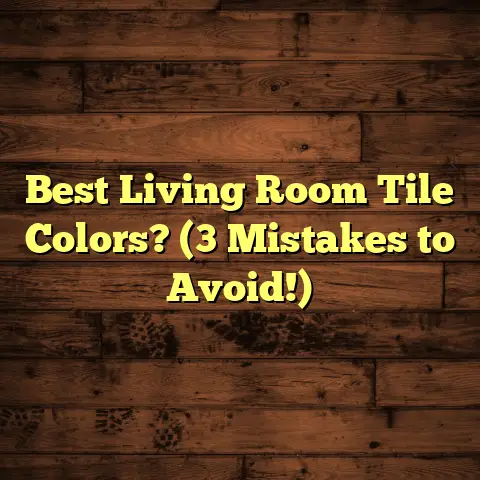Vinegar On Porcelain Tile? (1 Mistake To Avoid!)
I know that feeling, right?
The one where you walk into your kitchen, sunlight streaming through the window, and your porcelain tile floor is gleaming.
It’s more than just clean; it’s inviting, a place where memories are made, where family gathers, and life happens.
I remember one Thanksgiving, the whole family crammed into our kitchen.
The laughter, the aromas, the sheer joy of it all.
That polished floor reflected it all back,
a perfect picture of home.
And let’s be honest, after a feast like that, the cleanup is a beast.
That’s when many of us reach for a trusted friend:
vinegar.
It’s cheap, it’s natural,
and it seems to cut through grime like magic.
But what if I told you that your trusty cleaning companion could actually be doing more harm than good?
Yep, you read that right.
Using vinegar on porcelain tile can be a slippery slope, and there’s one major mistake I see homeowners make all the time.
Let’s dive in, shall we?
The Allure of Vinegar: Why We Love It
Why is vinegar such a popular cleaning agent?
Well, for starters, it’s been around forever.
Grandma used it, Mom used it,
and maybe you’re using it too.
It’s inexpensive, readily available, and boasts some serious cleaning power.
Think about it: vinegar is a natural acid.
It’s fantastic at breaking down grease,
hard water stains, and even some types of mold.
Plus, it’s a green alternative to harsh chemicals, which is a big win for the environment and for those of us with sensitive noses.
I’ve heard countless stories from folks who swear by vinegar for everything from cleaning their coffee makers to deodorizing their laundry.
One client, Sarah, told me she used a vinegar and water solution to mop her porcelain floors every week for years.
“It always left them sparkling!” she said.
And that’s the thing – for some, it does work.
But here’s where things get tricky.
Porcelain Tile 101: Know Your Surface
Before we get to the big mistake, let’s talk about porcelain tile.
What exactly is it, and why is it such a popular choice for floors and walls?
Porcelain tile is a type of ceramic tile, but it’s made using a specific type of clay and fired at much higher temperatures.
This process makes it incredibly dense, durable, and water-resistant.
In fact, according to the Tile Council of North America (TCNA), porcelain tile must have a water absorption rate of 0.5% or less to be classified as porcelain.
That’s why it’s a fantastic option for bathrooms, kitchens, and even outdoor spaces.
You’ll find porcelain tile in a huge range of styles, from sleek and modern to rustic and traditional.
Some are glazed, which means they have a protective coating on top, while others are unglazed, exposing the natural beauty of the tile.
And that glaze, my friends, is where our vinegar story takes a turn.
Vinegar on Porcelain: The Good, the Bad, and the Ugly
Okay, so we know vinegar can be a powerful cleaner, and we know that porcelain tile is a durable material.
What could possibly go wrong?
Well, on the pro side, vinegar can indeed cut through dirt and grime on porcelain tile.
Its acidity helps to loosen stubborn stains, and it doesn’t leave behind harsh chemical residues.
Plus, that clean, slightly sour scent is a lot more appealing than the smell of some commercial cleaners, right?
But here’s the con: vinegar is acidic.
And acid can react with certain materials,
especially the glaze on some porcelain tiles.
Over time, regular use of vinegar can dull the finish, making your once-sparkling tiles look cloudy and lifeless.
I’ve seen it happen firsthand.
Tiles that were once vibrant and reflective become dull and lackluster, all because of repeated vinegar treatments.
This is especially true for tiles with a high-gloss finish.
The acid in the vinegar can actually etch the surface, creating microscopic scratches that scatter light and reduce shine.
Imagine that beautiful kitchen I described earlier.
Now picture that same kitchen, but with
a dull, scratched floor.
Not quite the same feeling, is it?
The ONE Mistake: Using Too Much, Too Often
Alright, let’s get to the heart of the matter.
The one mistake that homeowners make
when using vinegar on porcelain tile?
Using too much, too often.
It seems simple, but it’s a critical point.
A little vinegar can be helpful for spot cleaning or removing tough stains.
But using a strong vinegar solution every week, or even every day, is a recipe for disaster.
The constant exposure to acid gradually wears down the glaze, leading to that dull, etched appearance I mentioned earlier.
Think of it like this: you wouldn’t scrub your car with sandpaper every week, would you?
Even though your car’s paint is durable, that kind of abrasive treatment would eventually damage the finish.
The same principle applies to porcelain tile.
I’ve had clients tell me, “But I thought vinegar
was natural and safe!
I didn’t realize it
could actually harm my tiles.”
And that’s the misconception. “Natural” doesn’t always mean “harmless.”
Lemon juice is natural, but you wouldn’t leave it sitting on your granite countertop, would you?
The acidity can etch the stone.
The same goes for vinegar and certain types of porcelain tile.
So, how do you know if you’re making this mistake?
Ask yourself these questions:
- How often do I use vinegar to clean my porcelain tile?
- What concentration of vinegar do I use?
- Have I noticed any dullness or scratching on my tiles?
If you’re using vinegar frequently and at a high concentration, and you’re starting to see changes in your tile’s appearance, it’s time to rethink your cleaning routine.
Real-Life Case Study: The Dull Bathroom Floor
I was called out to a home in the suburbs where the homeowner, Mrs. Davison, had a recurring issue with her bathroom floor.
She had beautiful, high-gloss porcelain tiles installed just a few years prior.
However, over time, she noticed that the tiles were losing their shine and starting to look dull, especially around the shower area.
During my inspection, I found that the tiles were indeed losing their luster.
When I asked Mrs. Davison about her cleaning routine, she proudly explained that she used a mixture of vinegar and water to clean the floor every other day.
She believed that because vinegar was a natural cleaner, it was the best and safest option for her tiles.
I explained to her that while vinegar is an excellent natural cleaner, its acidity could be the culprit behind the dullness.
The frequent use of vinegar was slowly etching away at the tile’s glaze, causing it to lose its reflective properties.
To remedy the situation, I recommended that Mrs. Davison switch to a pH-neutral cleaner specifically designed for porcelain tiles.
I also suggested a one-time professional cleaning to help restore some of the shine.
Mrs. Davison followed my advice, and within a few months, she noticed a significant improvement in the appearance of her bathroom floor.
This case is a perfect example of how the well-intentioned use of vinegar can lead to unintended damage to porcelain tiles.
So, What Should You Use?
Okay, so I’ve told you what not to do.
Now, let’s talk about what to do.
If you want to keep your porcelain tiles looking their best, there are plenty of safe and effective alternatives to vinegar.
Here are a few options:
- pH-Neutral Cleaners: These are specifically designed for tile and stone and won’t damage the finish.
- Mild Dish Soap: A small amount of dish soap in warm water can be effective for general cleaning.
- Commercial Tile Cleaners: Look for products specifically formulated for porcelain tile.
The key is to choose a cleaner that is gentle, non-abrasive, and compatible with your tile’s finish.
Conclusion: Protect Your Investment
Your home is more than just a building; it’s a sanctuary, a place of comfort and joy.
And your porcelain tile floors play a big role in creating that atmosphere.
By understanding the potential risks of using vinegar and choosing the right cleaning products, you can keep your tiles looking beautiful for years to come.
Remember, a little knowledge goes a long way.
Don’t let a simple cleaning mistake diminish the beauty of your home.
Choose wisely, clean gently, and enjoy the sparkling results!





